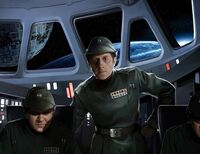| | |

An Imperial Admiral
- "An admiral must go down with his ship."
- ―Admiral Shoan Kilian
The title of Admiral signified senior command rank in many navies and starfleets. Admirals, also known generally as flag officers, were typically responsible for a high level military command at battle group or fleet level, and/or for administrative and political duties relating to naval operations.
Basic terminology

Shoan Kilian, an Admiral of the Galactic Republic fleet during the Clone Wars
- "A wise admiral is never surprised by a scenario, for he has run them all in his head during sleepless nights."
- ―Admiral Gial Ackbar
Most navies made use of various grades of admiral, with the basic hierarchy of Rear Admiral, Vice Admiral and full admiral seemingly almost universal. Below rear-admiral, the position of commodore was often regarded as a junior flag rank, and at least one instance of a Brevet Admiral is known. Some navies also had superior flag ranks above full Admiral, such as the Admiral of the Fleet in the Rebel Alliance and New Republic, and Grand Admirals under the Galactic Empire and the Galactic Alliance.
Galactic Republic
A number of Admirals were known to have served the Galactic Republic in the fortieth century BBY, during the Mandalorian Wars and the Jedi Civil War, but the use of the title seems to have been reasonably restricted: in the Great Sith War, the main Republic fleet had been commanded by Captain Orley Vanicus, and captains like Saul Karath continued to serve subsequently as battle group commanders.
Little is known about flag ranks in the subsequent millennia of Old Republic history, and during the Clone Wars, captains like Gilad Pellaeon and Sagoro Autem were once again found as squadron and fleet commanders. However, a few admirals were known to have held field commands, such as Arikakon Baraka, a Mon Calamari who commanded the supercruiser Nexu, and the Sakiyan Tarnese Bleyd, who commanded at Drongar. Curiously, whereas Pellaeon and Autem commanded significant task forces of capital ships, these admirals apparently had only their own command ships and attached surface units under their authority, but it may be significant that both Bleyd and Baraka seem to have had no Jedi Generals in their chain of command, and were thus the ultimate authority for the clone troopers of their commands.
Other flag officers held high positions on Coruscant, a situation that perhaps predated the Clone Wars, and indeed may have continued from before the Ruusan Reformation. An admiral named Jerjerrod is recorded serving at Naval Command, while an Admiral Kiner is named as the Republic's last important counter-espionage expert before its security and spying networks were amalgamated into Imperial Intelligence. Ronnan Tyla Vedij may likewise have reached flag rank under the Republic rather than the New Order.
Alliance and New Republic

Gial Ackbar, admiral of the Rebel Alliance and the New Republic
Under the Rebel Alliance, each battle line was commanded by a Line Admiral: the only two officers who can be said to have held a different level of flag rank are Gial Ackbar, styled "Admiral of the Fleet" as the Alliance's overall naval commander, and the Quarren Wirriz, who is known to have held the rank of vice admiral. Wirriz's rank probably indicates the use of the standard three-tier structure of flag ranks within Alliance forces, but in the absence of further proof, other interpretations remain possible: for instance, the title of Vice Admiral might have been accorded to the naval second-in-command, with all further flag officers being line admirals.
Under the New Republic, the ranks of commodore, rear admiral and vice admiral are recorded explicitly, and it is likely that full admirals also existed, although the more ambiguous range of meaning of the simple term admiral means that conclusive evidence is lacking. Thus, while it is known that an admiral was graded 'C-1' and regarded as equivalent to a general in the chain of command, it may be that this definition in fact extended to all New Republic flag officers.
Strictly speaking, there is only actually evidence for a rank of "Vice Admiral (retired)", held by the veteran Bothan commander Kursk Mal'ia, after he stood down from active duty. This could have been an honorary appointment granted at the end of a career, and as with the Rebellion, it cannot ultimately be ruled out that all active-duty "admirals" in the New Republic were, in fact, basically rear admirals.
At the head of the New Republic fleet hierarchy, the style "Admiral of the Fleet" remained Ackbar's unique prerogative, reflecting his decades of service as Supreme Commander. Perhaps in respect of Ackbar's reputation, his successor Sien Sovv opted to use the title Fleet Admiral instead, which was awarded to at least one other admiral serving alongside him during the Yuuzhan Vong War, the Bothan Traest Kre'fey.

Firmus Piett, an Admiral of the Imperial Navy
In the Imperial Navy, to cope with the immense expansion in the size of the fleet, a number of additional flag ranks were created within the Sector Group hierarchy. A simple style of admiral denoted the lowest of these grades, indicating command of a squadron of capital ships, and a rank not markedly higher than Captain of the Line. Above this came a hierarchy of Systems Admirals and Fleet Admirals under the High Admiral of the Sector, usually a Moff. In some cases within the context of Imperial Admirals, the term "admiral" can also be used as a general term for various Admirals even if their actual rank was higher than the simple style. An admiral in the Imperial Navy commanded ten times as many forces as an admiral of the same rank did under the Galactic Republic.
The Empire also retained a normal hierarchy of rear admirals, vice admirals, and full admirals, but the exact relationship of these ranks to the Sector Group titles is unclear. What is known for sure is that Michael Unther, having previously served as a fleet admiral or even a High Admiral, was subsequently promoted to rear admiral, normally the most junior substantive flag rank. It is possible that many Sector Group Admirals may have been little more than senior captains, in a system perhaps connected with the unusual usage of the title of commander recorded in the Imperial Navy. Although most promotions to Admiral were treated as an honor, admirals who were promoted aboard and assigned to the Star Dreadnought Executor were an exception, with many of its junior officers forming betting pools on its admiral's life expectancy due to the vessel's infamous reputation as the Imperial enforcer Darth Vader's flagship and its various admirals suffering from summary execution from failure as a result.[1]
In 2 BBY, a rank of Grand Admiral was created, ranking above all other Imperial flag officers, but shortly before the Battle of Endor, Lord Darth Vader was appointed Supreme Commander.
Confederation
In the Confederation during the Second Galactic Civil War, the military forces were led by people holding the rank of Admiral. The most notable of these was Wedge Antilles, who briefly commanded the Corellian forces until breaking with the government in the aftermath of their attempted assassination of Tenel Ka Djo.
See also
| Rank | Insignia | |
| Admiral | ||
- Commodore
- Brevet Admiral
- Rear Admiral
- Vice Admiral
- Fleet Admiral
- High Admiral
- Grand Admiral
- Systems Admiral
- Supreme Admiral
- Lord High Admiral
- Prince-Admiral
- Admiral of the Fleet
- Supreme Commander
 Admiral on Wikipedia
Admiral on Wikipedia
Behind the scenes
The usage of flag ranks in Star Wars is generally based on real-world conventions, but there are exceptions to this, most notably in the Imperial Sector Group hierarchy discussed above.
Also, the lack of categorical references to full Admirals in the navies of the Rebel Alliance and New Republic cannot be countermanded by appeal to real-world standards: as the evolution of flag ranks in the United States Navy shows, scenarios are possible in which only part of the usual hierarchy of Admirals' ranks is used.
